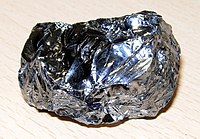
Photo from wikipedia
Abstract Biomasses are a sustainable, CO 2 neutral source used in biorefining. Si-accumulating plants can be used for the production of biogenic silica in a biomass valorisation process. This study… Click to show full abstract
Abstract Biomasses are a sustainable, CO 2 neutral source used in biorefining. Si-accumulating plants can be used for the production of biogenic silica in a biomass valorisation process. This study examines the production of high-grade porous silica from different plant parts like rice, oat and spelt husk, rice straw and horsetail using a generalized procedure for all. The silica materials were produced by a 2-step method. First, the biomasses were pretreated with water and then subjected to leaching with citric acid. As a second step, a sequential burning program was applied. The characterization of the untreated biomasses was carried out by X-ray fluorescence (XRF) analysis and thermal analysis (TG–DTA). The biogenic silica samples were subjected to XRF, carbon content analysis, low temperature nitrogen physisorption, scanning and transmission electron microscopy as well as X-ray diffraction. Independent of the initial composition of the plant part, the established method resulted in amorphous, biogenic silica with up to 99.7% purity, mesopores between 2 and 30 nm with pore volumes of up to 0.46 cm 3 g −1 and specific surfaces of up to 303 m 2 g −1 . It was shown that the generalized method developed works not only for all the biomasses separately, but also if treated in the same batch. The produced biogenic silica can be considered as sustainable alternative to other silica products like precipitated silica, silica gel and fumed silica which are produced in highly energy consuming processes. Graphical Abstract
Journal Title: Waste and Biomass Valorization
Year Published: 2020
Link to full text (if available)
Share on Social Media: Sign Up to like & get
recommendations!